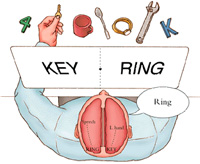 15) Consciousness depends on cortical communication; the cortical hemispheres are functionally specialized (Sperry & Gazzaniga – 1969)
15) Consciousness depends on cortical communication; the cortical hemispheres are functionally specialized (Sperry & Gazzaniga – 1969)
It is quite difficult to localize the epileptic origin in some seizure patients. Rather than removing the gray matter of origin, neurosurgeons sometimes remove white matter to restrict the seizure to one part of the brain.
One particularly invasive procedure (the callosotomy) restricts the seizure to one half of cortex by removing the connections between the two halves. This is normally very effective in reducing the intensity of epileptic events. However, Sperry & Gazzaniga found that it comes at a price.
They found that presenting a word to the right visual field of a patient without a corpus callosum allowed only the patient’s left hemisphere to become aware of that word (and vice versa). When only the side opposite the one which was presented the word was allowed to respond, it had no idea what word had been presented.
The two hemispheres of cortex could not communicate, and thus two independent consciousnesses emerged.
Sperry & Gazzaniga also found that the left hemisphere, and not the right, could typically respond linguistically. This suggested that language is largely localized in the left hemisphere. (See the above figure for illustration.)
The functional distinction between the left and right hemispheres is supported by many lesion studies. Generally, the left hemisphere is specialized for language and abstract reasoning, while the right hemisphere is specialized for spatial, body, emotional, and environment awareness. The boundary between these specializations has been trivialized in the popular media; it is actually quite complex and, in healthy brains, quite subtle.
Implication: The mind, largely governed by reward-seeking behavior, is implemented in an electro-chemical organ with distributed and modular function consisting of excitatory and inhibitory neurons communicating via ion-induced action potentials over convergent and divergent synaptic connections strengthened by correlated activity. The cortex, a part of that organ composed of functional column units whose spatial dedication determines representational resolution, is composed of many specialized regions involved in perception (e.g., touch: parietal lobe, vision: occipital lobe), action (e.g., frontal lobe), and memory (e.g., temporal lobe), which depend on inter-regional communication for functional integration.
[This post is part of a series chronicling history’s top brain computation insights (see the first of the series for a detailed description). See the history category archive to see all of the entries.]
-MC
